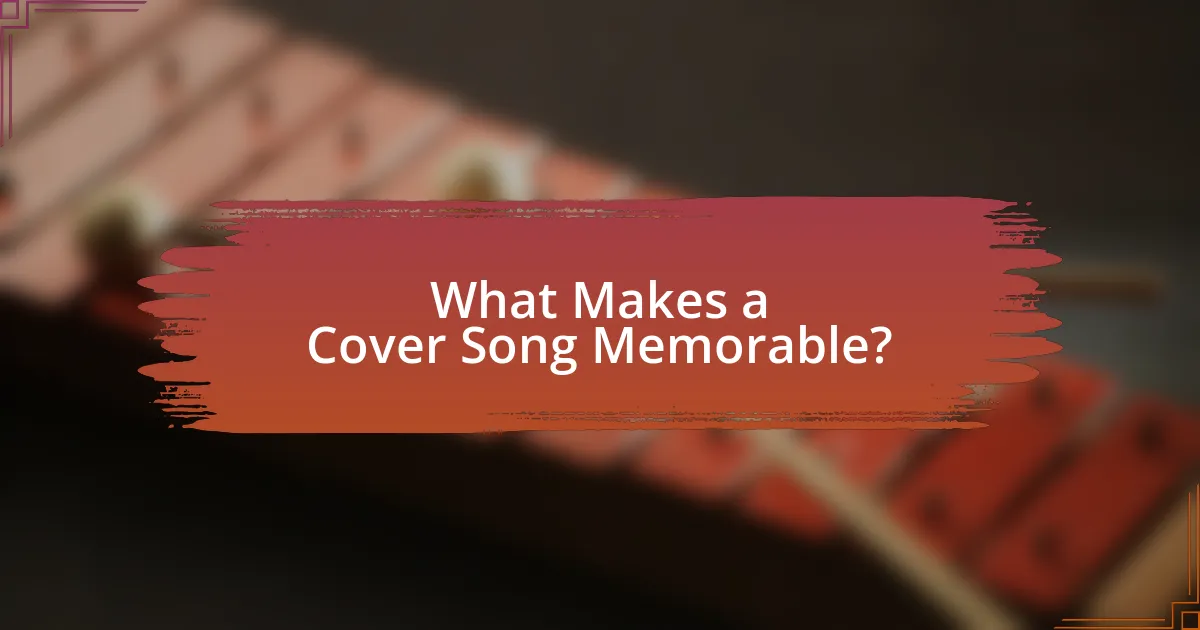Cover songs are reinterpretations of original music performed by different artists, playing a significant role in the music industry by honoring original works, reaching new audiences, and showcasing artistic versatility. This article explores the distinction between cover songs and original compositions, the legal implications of creating covers, and the factors influencing artists’ choices in selecting songs to reinterpret. It also examines the emotional connections listeners form with cover songs, the elements that contribute to their memorability, and the impact of iconic covers on popular culture. Additionally, the article highlights successful cover songs and the lessons emerging artists can learn from them to effectively approach their own renditions.

What are Cover Songs and Their Significance in Music?
Cover songs are reinterpretations of original songs performed by different artists, often bringing new styles or perspectives to the music. Their significance in music lies in their ability to pay homage to the original work, introduce the song to new audiences, and showcase the versatility of the piece across different genres. For instance, Whitney Houston’s cover of “I Will Always Love You” not only revitalized Dolly Parton’s original but also became a cultural phenomenon, demonstrating how a cover can achieve greater commercial success and emotional impact than the original. Cover songs also foster artistic collaboration and innovation, as artists often infuse their unique interpretations, thereby enriching the musical landscape.
How do cover songs differ from original compositions?
Cover songs differ from original compositions primarily in their source material; cover songs reinterpret existing works, while original compositions are created from new ideas. Cover songs maintain the melody and structure of the original piece but often feature different arrangements, vocal styles, or instrumentation, allowing artists to express their unique interpretations. For instance, Jimi Hendrix’s cover of Bob Dylan’s “All Along the Watchtower” transformed the song into a rock classic, showcasing how reinterpretation can lead to new artistic expressions. This distinction highlights the creative process involved in both forms of music, where originality is rooted in the creation of new content, while covers build upon and pay homage to existing works.
What are the legal implications of creating a cover song?
Creating a cover song requires obtaining a mechanical license, which grants permission to reproduce and distribute the original composition. This legal requirement is mandated by U.S. copyright law, specifically under the Copyright Act of 1976, which allows for the creation of derivative works, including cover songs, as long as the original songwriter is compensated. The license can be obtained through organizations like the Harry Fox Agency or directly from the copyright holder. Failure to secure this license can result in copyright infringement, leading to legal consequences such as fines or lawsuits.
How do artists choose songs to cover?
Artists choose songs to cover based on personal connection, audience appeal, and the potential for creative reinterpretation. Personal connection often stems from the artist’s emotional resonance with the original song, which can enhance authenticity in their rendition. Audience appeal is crucial, as artists consider what songs will engage their fan base and attract new listeners. Additionally, the potential for creative reinterpretation allows artists to bring a fresh perspective to a well-known track, making it relevant to contemporary audiences. For instance, when Johnny Cash covered “Hurt” by Nine Inch Nails, he infused the song with his own life experiences, creating a powerful and memorable version that resonated with both his fans and the original artist’s audience.
Why do artists create cover songs?
Artists create cover songs to pay homage to original works, reinterpret them, and reach new audiences. By covering a song, artists can showcase their unique style while introducing the original piece to listeners who may not be familiar with it. For instance, when Whitney Houston covered “I Will Always Love You,” she not only honored Dolly Parton’s original but also transformed it into a global hit, demonstrating how covers can elevate a song’s popularity and emotional impact. This practice is common in the music industry, as evidenced by numerous successful covers across genres, highlighting the significance of reinterpretation in artistic expression.
What role do cover songs play in an artist’s career?
Cover songs play a significant role in an artist’s career by enhancing their visibility and showcasing their versatility. By performing covers, artists can reach new audiences who may be familiar with the original songs, thereby expanding their fan base. For instance, when artists like Whitney Houston covered “I Will Always Love You,” it not only revitalized the song but also introduced her to listeners who may not have been aware of her previous work. Additionally, covers can demonstrate an artist’s unique interpretation and style, which can lead to increased recognition and opportunities in the music industry. This is evidenced by the fact that many successful artists, such as Adele and John Mayer, have included covers in their discographies, contributing to their commercial success and critical acclaim.
How do cover songs contribute to the music industry?
Cover songs contribute to the music industry by generating revenue, expanding audience reach, and fostering artistic innovation. They allow established artists to introduce classic tracks to new generations, which can lead to increased sales and streaming of both the cover and the original song. For instance, when Whitney Houston covered “I Will Always Love You,” it became one of the best-selling singles of all time, significantly boosting Dolly Parton’s original version’s sales and royalties. Additionally, cover songs often inspire new interpretations and styles, enriching the musical landscape and encouraging collaboration among artists. This dynamic not only enhances the cultural relevance of the music industry but also creates opportunities for emerging artists to gain exposure through their renditions of popular songs.

What Makes a Cover Song Memorable?
A cover song becomes memorable primarily due to its emotional resonance and unique interpretation. When an artist infuses their personal style or perspective into a familiar song, it can evoke new feelings or memories for listeners, making the rendition stand out. For instance, Jeff Buckley’s cover of Leonard Cohen’s “Hallelujah” is often cited as memorable because Buckley’s haunting vocal delivery and emotional depth transformed the original, leading to widespread acclaim and a lasting impact on audiences. This demonstrates that a combination of emotional connection and innovative artistry contributes significantly to the memorability of cover songs.
How does an artist’s interpretation affect a cover song’s impact?
An artist’s interpretation significantly affects a cover song’s impact by altering its emotional resonance and stylistic presentation. When an artist reinterprets a song, they can infuse it with their unique vocal style, instrumentation, and personal experiences, which can lead to a fresh perspective that resonates differently with audiences. For instance, Jeff Buckley’s cover of Leonard Cohen’s “Hallelujah” transformed the original’s somber tone into a hauntingly beautiful rendition that gained widespread acclaim, illustrating how a new interpretation can elevate a song’s emotional depth and reach. This shift in interpretation can also attract new listeners who may connect more with the cover than the original, demonstrating the profound influence an artist’s approach has on a song’s legacy and cultural significance.
What elements contribute to a unique rendition of a song?
A unique rendition of a song is primarily influenced by vocal interpretation, instrumentation, arrangement, and emotional expression. Vocal interpretation involves the singer’s unique style, tone, and delivery, which can significantly alter the song’s impact. Instrumentation refers to the choice of instruments and their arrangement, which can create a distinct sound that sets the rendition apart from the original. The arrangement encompasses how the song is structured, including changes in tempo, key, and dynamics, allowing for creative reinterpretation. Emotional expression is crucial, as the artist’s ability to convey feelings can resonate differently with the audience, making the rendition memorable. These elements collectively contribute to the uniqueness of a cover song, as evidenced by successful renditions like Jeff Buckley’s version of “Hallelujah,” which showcases a different emotional depth and musical arrangement compared to Leonard Cohen’s original.
How do vocal style and instrumentation influence a cover’s reception?
Vocal style and instrumentation significantly influence a cover’s reception by shaping the emotional impact and listener engagement. A unique vocal interpretation can evoke different feelings compared to the original, as seen in Jeff Buckley’s cover of “Hallelujah,” where his haunting vocal delivery added depth and vulnerability, leading to widespread acclaim. Similarly, instrumentation alters the song’s atmosphere; for instance, Johnny Cash’s stripped-down version of “Hurt” utilized minimalistic guitar and piano, enhancing the song’s somber tone and resonating deeply with audiences. These elements collectively determine how listeners perceive and connect with a cover, often leading to a re-evaluation of the original work.
Why do certain cover songs resonate with audiences more than others?
Certain cover songs resonate with audiences more than others due to their emotional connection, unique interpretation, and cultural relevance. Emotional connection arises when the cover artist conveys feelings that align with the original song’s intent, often enhanced by personal experiences or vocal delivery. Unique interpretation can attract listeners by offering a fresh perspective or innovative arrangement, making the song feel new while retaining its essence. Cultural relevance plays a crucial role, as covers that align with current social issues or trends can amplify their impact, making them more relatable to audiences. For example, Whitney Houston’s rendition of “I Will Always Love You” became iconic not only due to her powerful vocal performance but also because it resonated with themes of love and loss that many listeners could relate to at the time of its release.
What emotional connections do listeners form with cover songs?
Listeners form deep emotional connections with cover songs by experiencing nostalgia, familiarity, and reinterpretation of original works. Nostalgia arises when a cover song evokes memories associated with the original, often linked to significant life events or personal experiences. Familiarity plays a crucial role as listeners may feel comforted by the recognizable melody or lyrics, creating a sense of belonging. Additionally, reinterpretation allows listeners to connect with the artist’s unique expression, often leading to new emotional insights or perspectives on the original song. Research indicates that covers can elicit strong emotional responses, as they often tap into shared cultural memories and collective experiences, reinforcing the bond between the listener and the music.
How does nostalgia play a role in the popularity of cover songs?
Nostalgia significantly enhances the popularity of cover songs by evoking emotional connections to past experiences and memories associated with the original tracks. When listeners hear a cover of a song they loved in their youth, it often triggers a sense of familiarity and comfort, making them more likely to engage with the new rendition. Research indicates that nostalgia can increase feelings of social connectedness and happiness, which in turn boosts the appeal of music that resonates with personal or collective memories. For example, a study published in the journal “Psychology of Music” found that nostalgic songs can elicit strong emotional responses, leading to increased enjoyment and preference for those songs, including covers. This emotional resonance is a key factor in why cover songs often achieve commercial success and widespread acclaim.
![]()
What Are Some Iconic Cover Songs and Their Stories?
Some iconic cover songs include “Hallelujah” by Jeff Buckley, “I Will Always Love You” by Whitney Houston, and “All Along the Watchtower” by Jimi Hendrix. Jeff Buckley’s rendition of “Hallelujah,” originally by Leonard Cohen, transformed the song into a haunting ballad that gained immense popularity after Buckley’s death in 1997, showcasing his emotional depth and vocal range. Whitney Houston’s cover of “I Will Always Love You,” originally by Dolly Parton, became a global hit in 1992, largely due to its powerful delivery in “The Bodyguard” soundtrack, making it one of the best-selling singles of all time. Jimi Hendrix’s version of “All Along the Watchtower,” originally by Bob Dylan, redefined the song with its electric guitar riffs and became a staple of rock music, illustrating Hendrix’s innovative style and interpretation. Each of these covers not only honors the original artists but also adds a unique perspective that resonates with audiences, solidifying their place in music history.
Which cover songs have achieved critical and commercial success?
Cover songs that have achieved critical and commercial success include “Hallelujah” by Jeff Buckley, “I Will Always Love You” by Whitney Houston, and “All Along the Watchtower” by Jimi Hendrix. Jeff Buckley’s rendition of “Hallelujah” is widely regarded as one of the greatest cover songs, receiving acclaim from critics and listeners alike, and has been featured in numerous films and television shows. Whitney Houston’s version of “I Will Always Love You” topped the Billboard Hot 100 for 14 weeks and is one of the best-selling singles of all time. Jimi Hendrix’s cover of “All Along the Watchtower” transformed Bob Dylan’s original into a rock classic, earning significant praise and becoming one of Hendrix’s signature songs. These covers not only achieved commercial success but also left a lasting impact on music history.
What are the stories behind famous cover songs?
Famous cover songs often originate from a desire to reinterpret or pay homage to the original work, leading to unique stories behind each rendition. For example, Whitney Houston’s cover of “I Will Always Love You” transformed Dolly Parton’s country ballad into a pop and R&B classic, showcasing Houston’s powerful vocal range and emotional delivery, which contributed to its massive commercial success and cultural impact. Similarly, Jimi Hendrix’s rendition of Bob Dylan’s “All Along the Watchtower” redefined the song with a rock perspective, making it one of Hendrix’s signature pieces and introducing it to a new audience. These covers not only highlight the artists’ creativity but also demonstrate how reinterpretation can breathe new life into existing music, often leading to greater recognition for the original songwriters.
How have these cover songs influenced popular culture?
Cover songs have significantly influenced popular culture by introducing classic tracks to new audiences and reshaping musical genres. For instance, Whitney Houston’s cover of “I Will Always Love You” revitalized Dolly Parton’s original, leading to a resurgence in interest in both artists and the country genre in the early 1990s. Additionally, cover songs often spark conversations about artistic interpretation and ownership, as seen with Jimi Hendrix’s rendition of Bob Dylan’s “All Along the Watchtower,” which became a defining version of the song and influenced rock music’s direction. Furthermore, covers can serve as cultural commentary, such as when artists like Johnny Cash covered Nine Inch Nails’ “Hurt,” providing a poignant reflection on themes of regret and mortality that resonated deeply with listeners. These examples illustrate how cover songs not only pay homage to original works but also play a crucial role in evolving musical landscapes and cultural dialogues.
What lessons can be learned from successful cover songs?
Successful cover songs demonstrate the importance of reinterpreting existing material to create a fresh experience while respecting the original. They teach artists to infuse their unique style and perspective into familiar songs, which can resonate with both new and existing audiences. For example, Whitney Houston’s rendition of “I Will Always Love You” transformed Dolly Parton’s original into a powerful ballad that achieved massive commercial success, showcasing how emotional delivery can elevate a song. Additionally, successful covers often highlight the significance of timing and cultural relevance, as seen in Johnny Cash’s cover of “Hurt,” which gained renewed attention and meaning in the context of his later life. These examples illustrate that successful cover songs can serve as a bridge between generations, allowing artists to connect with diverse audiences while honoring the legacy of the original creators.
How can emerging artists effectively approach covering songs?
Emerging artists can effectively approach covering songs by infusing their unique style and interpretation into the original material. This involves analyzing the song’s structure, lyrics, and emotional depth to identify elements that resonate with their artistic vision. For instance, artists like Jeff Buckley and Jimi Hendrix have successfully transformed existing songs by altering arrangements and vocal delivery, which not only showcases their individuality but also breathes new life into the original work. By doing so, they create a fresh experience for listeners while paying homage to the original artists.
What strategies can artists use to make their cover songs stand out?
Artists can make their cover songs stand out by incorporating unique arrangements, personal interpretations, and innovative production techniques. Unique arrangements can involve altering the song’s tempo, key, or instrumentation, which can create a fresh listening experience. Personal interpretations allow artists to infuse their own style and emotional depth into the song, making it resonate differently with audiences. Innovative production techniques, such as using modern technology or collaborating with different genres, can also enhance the overall sound and appeal. For instance, the cover of “Hallelujah” by Jeff Buckley is often cited for its haunting arrangement and emotional delivery, which transformed the original song into a new classic.



